MGT602 Business Decision Analytics: Individual Decision Style Analysis
VerifiedAdded on 2023/06/03
|8
|1720
|236
Report
AI Summary
This report reflects on decision-making styles, utilizing a decision preference test to determine the author's inclination towards logic, intuition, or balance. The author identifies a preference for logical decision-making, supported by diary entries detailing thoughts and feelings associated with each style. The report also explores the author's 'shadow side' through a personality test, revealing areas for improvement in interpersonal qualities and information processing. Self-development strategies and discussions with a mentor-partner are outlined to address these weaknesses and enhance decision-making capabilities. The analysis concludes that feedback from a mentor is crucial for personal and professional development, particularly in refining decision-making processes. Desklib offers a variety of resources for students, including solved assignments and past papers.
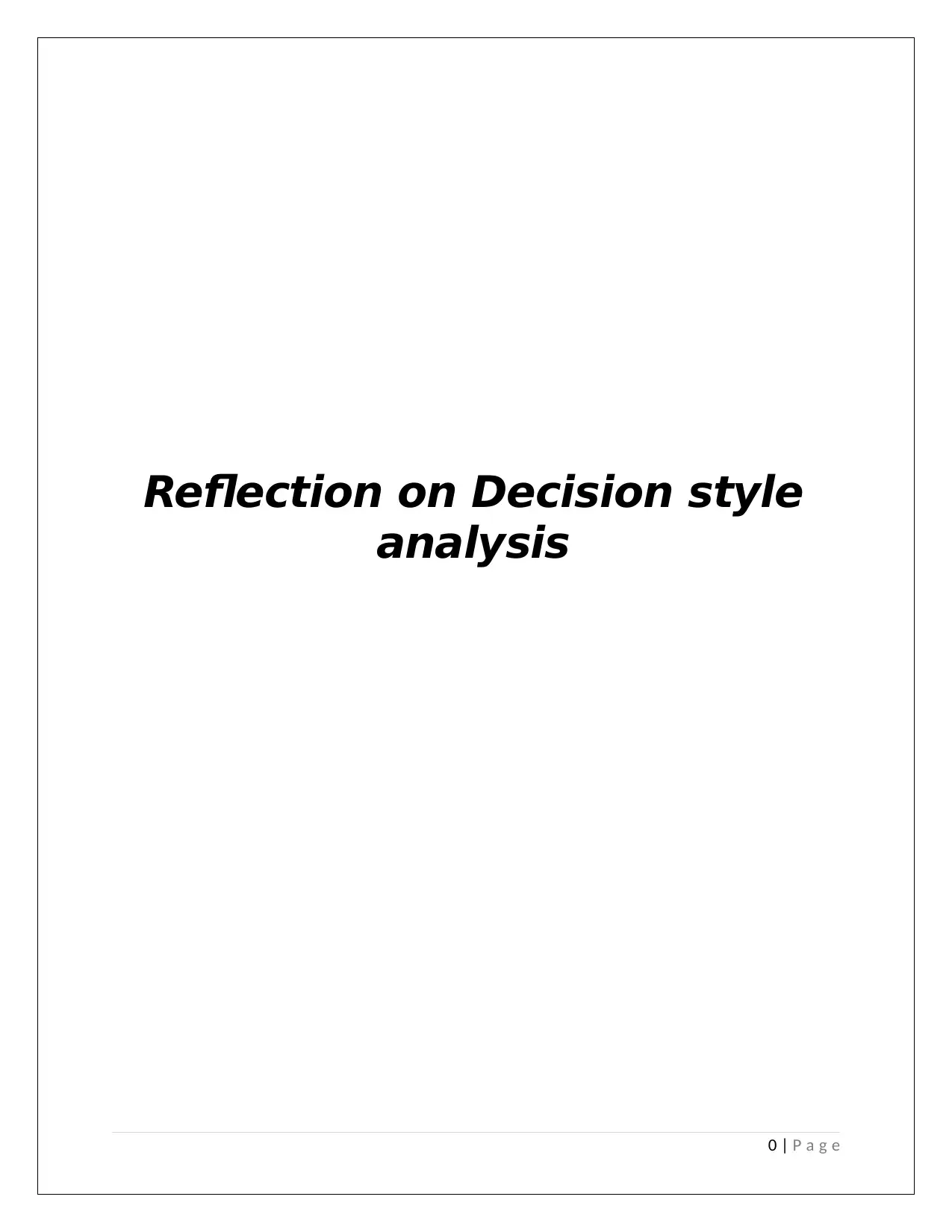
Reflection on Decision style
analysis
0 | P a g e
analysis
0 | P a g e
Paraphrase This Document
Need a fresh take? Get an instant paraphrase of this document with our AI Paraphraser
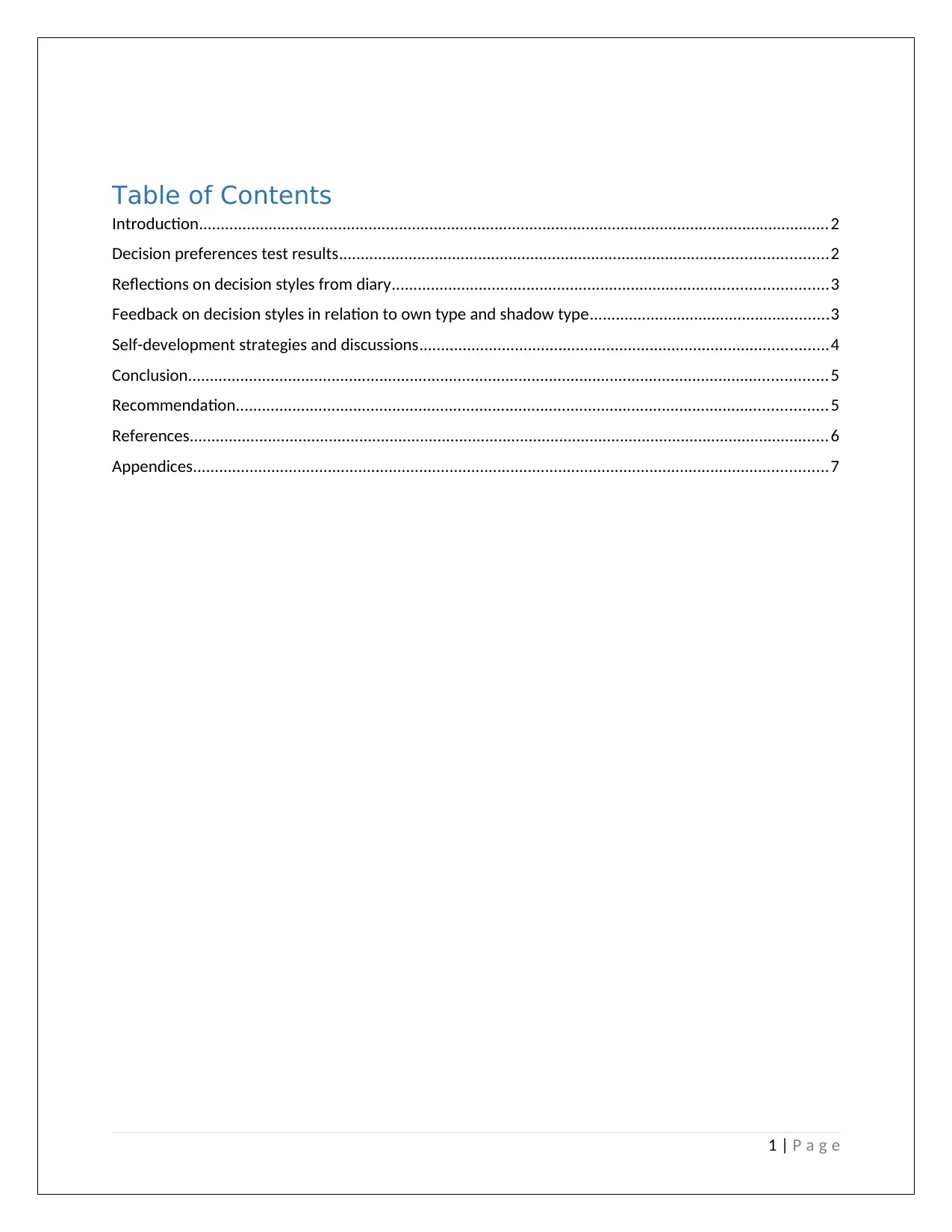
Table of Contents
Introduction.................................................................................................................................................2
Decision preferences test results................................................................................................................2
Reflections on decision styles from diary....................................................................................................3
Feedback on decision styles in relation to own type and shadow type.......................................................3
Self-development strategies and discussions..............................................................................................4
Conclusion...................................................................................................................................................5
Recommendation........................................................................................................................................5
References...................................................................................................................................................6
Appendices..................................................................................................................................................7
1 | P a g e
Introduction.................................................................................................................................................2
Decision preferences test results................................................................................................................2
Reflections on decision styles from diary....................................................................................................3
Feedback on decision styles in relation to own type and shadow type.......................................................3
Self-development strategies and discussions..............................................................................................4
Conclusion...................................................................................................................................................5
Recommendation........................................................................................................................................5
References...................................................................................................................................................6
Appendices..................................................................................................................................................7
1 | P a g e
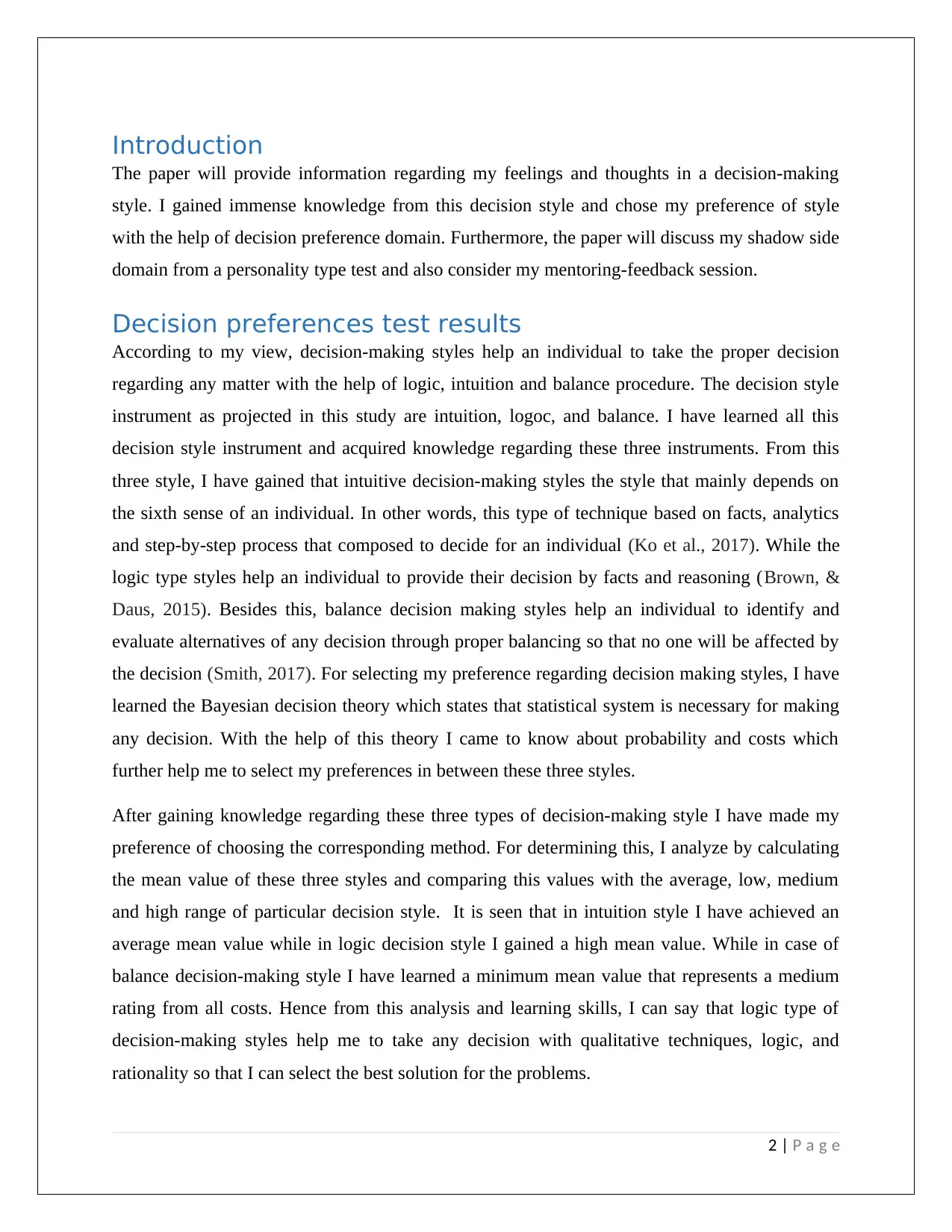
Introduction
The paper will provide information regarding my feelings and thoughts in a decision-making
style. I gained immense knowledge from this decision style and chose my preference of style
with the help of decision preference domain. Furthermore, the paper will discuss my shadow side
domain from a personality type test and also consider my mentoring-feedback session.
Decision preferences test results
According to my view, decision-making styles help an individual to take the proper decision
regarding any matter with the help of logic, intuition and balance procedure. The decision style
instrument as projected in this study are intuition, logoc, and balance. I have learned all this
decision style instrument and acquired knowledge regarding these three instruments. From this
three style, I have gained that intuitive decision-making styles the style that mainly depends on
the sixth sense of an individual. In other words, this type of technique based on facts, analytics
and step-by-step process that composed to decide for an individual (Ko et al., 2017). While the
logic type styles help an individual to provide their decision by facts and reasoning (Brown, &
Daus, 2015). Besides this, balance decision making styles help an individual to identify and
evaluate alternatives of any decision through proper balancing so that no one will be affected by
the decision (Smith, 2017). For selecting my preference regarding decision making styles, I have
learned the Bayesian decision theory which states that statistical system is necessary for making
any decision. With the help of this theory I came to know about probability and costs which
further help me to select my preferences in between these three styles.
After gaining knowledge regarding these three types of decision-making style I have made my
preference of choosing the corresponding method. For determining this, I analyze by calculating
the mean value of these three styles and comparing this values with the average, low, medium
and high range of particular decision style. It is seen that in intuition style I have achieved an
average mean value while in logic decision style I gained a high mean value. While in case of
balance decision-making style I have learned a minimum mean value that represents a medium
rating from all costs. Hence from this analysis and learning skills, I can say that logic type of
decision-making styles help me to take any decision with qualitative techniques, logic, and
rationality so that I can select the best solution for the problems.
2 | P a g e
The paper will provide information regarding my feelings and thoughts in a decision-making
style. I gained immense knowledge from this decision style and chose my preference of style
with the help of decision preference domain. Furthermore, the paper will discuss my shadow side
domain from a personality type test and also consider my mentoring-feedback session.
Decision preferences test results
According to my view, decision-making styles help an individual to take the proper decision
regarding any matter with the help of logic, intuition and balance procedure. The decision style
instrument as projected in this study are intuition, logoc, and balance. I have learned all this
decision style instrument and acquired knowledge regarding these three instruments. From this
three style, I have gained that intuitive decision-making styles the style that mainly depends on
the sixth sense of an individual. In other words, this type of technique based on facts, analytics
and step-by-step process that composed to decide for an individual (Ko et al., 2017). While the
logic type styles help an individual to provide their decision by facts and reasoning (Brown, &
Daus, 2015). Besides this, balance decision making styles help an individual to identify and
evaluate alternatives of any decision through proper balancing so that no one will be affected by
the decision (Smith, 2017). For selecting my preference regarding decision making styles, I have
learned the Bayesian decision theory which states that statistical system is necessary for making
any decision. With the help of this theory I came to know about probability and costs which
further help me to select my preferences in between these three styles.
After gaining knowledge regarding these three types of decision-making style I have made my
preference of choosing the corresponding method. For determining this, I analyze by calculating
the mean value of these three styles and comparing this values with the average, low, medium
and high range of particular decision style. It is seen that in intuition style I have achieved an
average mean value while in logic decision style I gained a high mean value. While in case of
balance decision-making style I have learned a minimum mean value that represents a medium
rating from all costs. Hence from this analysis and learning skills, I can say that logic type of
decision-making styles help me to take any decision with qualitative techniques, logic, and
rationality so that I can select the best solution for the problems.
2 | P a g e
⊘ This is a preview!⊘
Do you want full access?
Subscribe today to unlock all pages.

Trusted by 1+ million students worldwide
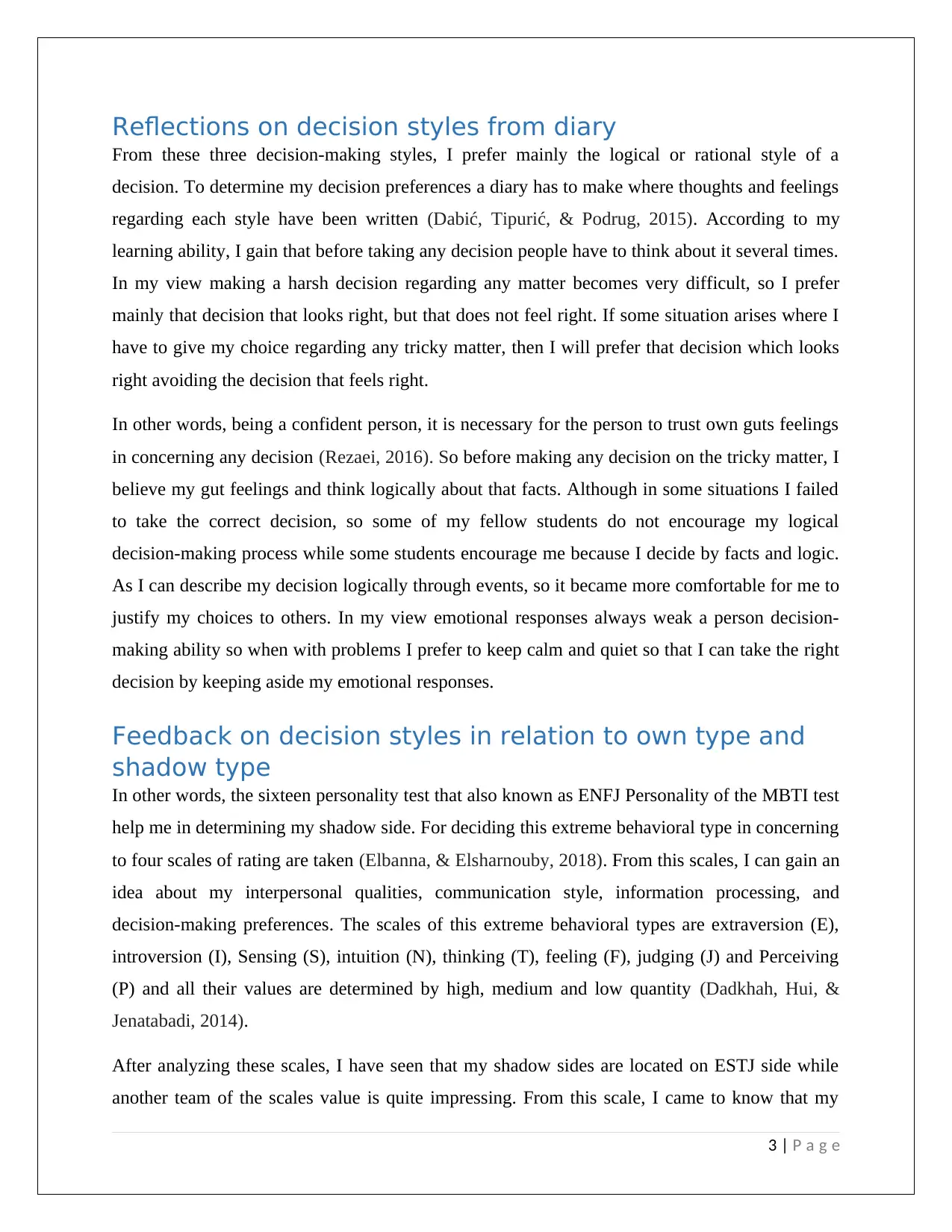
Reflections on decision styles from diary
From these three decision-making styles, I prefer mainly the logical or rational style of a
decision. To determine my decision preferences a diary has to make where thoughts and feelings
regarding each style have been written (Dabić, Tipurić, & Podrug, 2015). According to my
learning ability, I gain that before taking any decision people have to think about it several times.
In my view making a harsh decision regarding any matter becomes very difficult, so I prefer
mainly that decision that looks right, but that does not feel right. If some situation arises where I
have to give my choice regarding any tricky matter, then I will prefer that decision which looks
right avoiding the decision that feels right.
In other words, being a confident person, it is necessary for the person to trust own guts feelings
in concerning any decision (Rezaei, 2016). So before making any decision on the tricky matter, I
believe my gut feelings and think logically about that facts. Although in some situations I failed
to take the correct decision, so some of my fellow students do not encourage my logical
decision-making process while some students encourage me because I decide by facts and logic.
As I can describe my decision logically through events, so it became more comfortable for me to
justify my choices to others. In my view emotional responses always weak a person decision-
making ability so when with problems I prefer to keep calm and quiet so that I can take the right
decision by keeping aside my emotional responses.
Feedback on decision styles in relation to own type and
shadow type
In other words, the sixteen personality test that also known as ENFJ Personality of the MBTI test
help me in determining my shadow side. For deciding this extreme behavioral type in concerning
to four scales of rating are taken (Elbanna, & Elsharnouby, 2018). From this scales, I can gain an
idea about my interpersonal qualities, communication style, information processing, and
decision-making preferences. The scales of this extreme behavioral types are extraversion (E),
introversion (I), Sensing (S), intuition (N), thinking (T), feeling (F), judging (J) and Perceiving
(P) and all their values are determined by high, medium and low quantity (Dadkhah, Hui, &
Jenatabadi, 2014).
After analyzing these scales, I have seen that my shadow sides are located on ESTJ side while
another team of the scales value is quite impressing. From this scale, I came to know that my
3 | P a g e
From these three decision-making styles, I prefer mainly the logical or rational style of a
decision. To determine my decision preferences a diary has to make where thoughts and feelings
regarding each style have been written (Dabić, Tipurić, & Podrug, 2015). According to my
learning ability, I gain that before taking any decision people have to think about it several times.
In my view making a harsh decision regarding any matter becomes very difficult, so I prefer
mainly that decision that looks right, but that does not feel right. If some situation arises where I
have to give my choice regarding any tricky matter, then I will prefer that decision which looks
right avoiding the decision that feels right.
In other words, being a confident person, it is necessary for the person to trust own guts feelings
in concerning any decision (Rezaei, 2016). So before making any decision on the tricky matter, I
believe my gut feelings and think logically about that facts. Although in some situations I failed
to take the correct decision, so some of my fellow students do not encourage my logical
decision-making process while some students encourage me because I decide by facts and logic.
As I can describe my decision logically through events, so it became more comfortable for me to
justify my choices to others. In my view emotional responses always weak a person decision-
making ability so when with problems I prefer to keep calm and quiet so that I can take the right
decision by keeping aside my emotional responses.
Feedback on decision styles in relation to own type and
shadow type
In other words, the sixteen personality test that also known as ENFJ Personality of the MBTI test
help me in determining my shadow side. For deciding this extreme behavioral type in concerning
to four scales of rating are taken (Elbanna, & Elsharnouby, 2018). From this scales, I can gain an
idea about my interpersonal qualities, communication style, information processing, and
decision-making preferences. The scales of this extreme behavioral types are extraversion (E),
introversion (I), Sensing (S), intuition (N), thinking (T), feeling (F), judging (J) and Perceiving
(P) and all their values are determined by high, medium and low quantity (Dadkhah, Hui, &
Jenatabadi, 2014).
After analyzing these scales, I have seen that my shadow sides are located on ESTJ side while
another team of the scales value is quite impressing. From this scale, I came to know that my
3 | P a g e
Paraphrase This Document
Need a fresh take? Get an instant paraphrase of this document with our AI Paraphraser
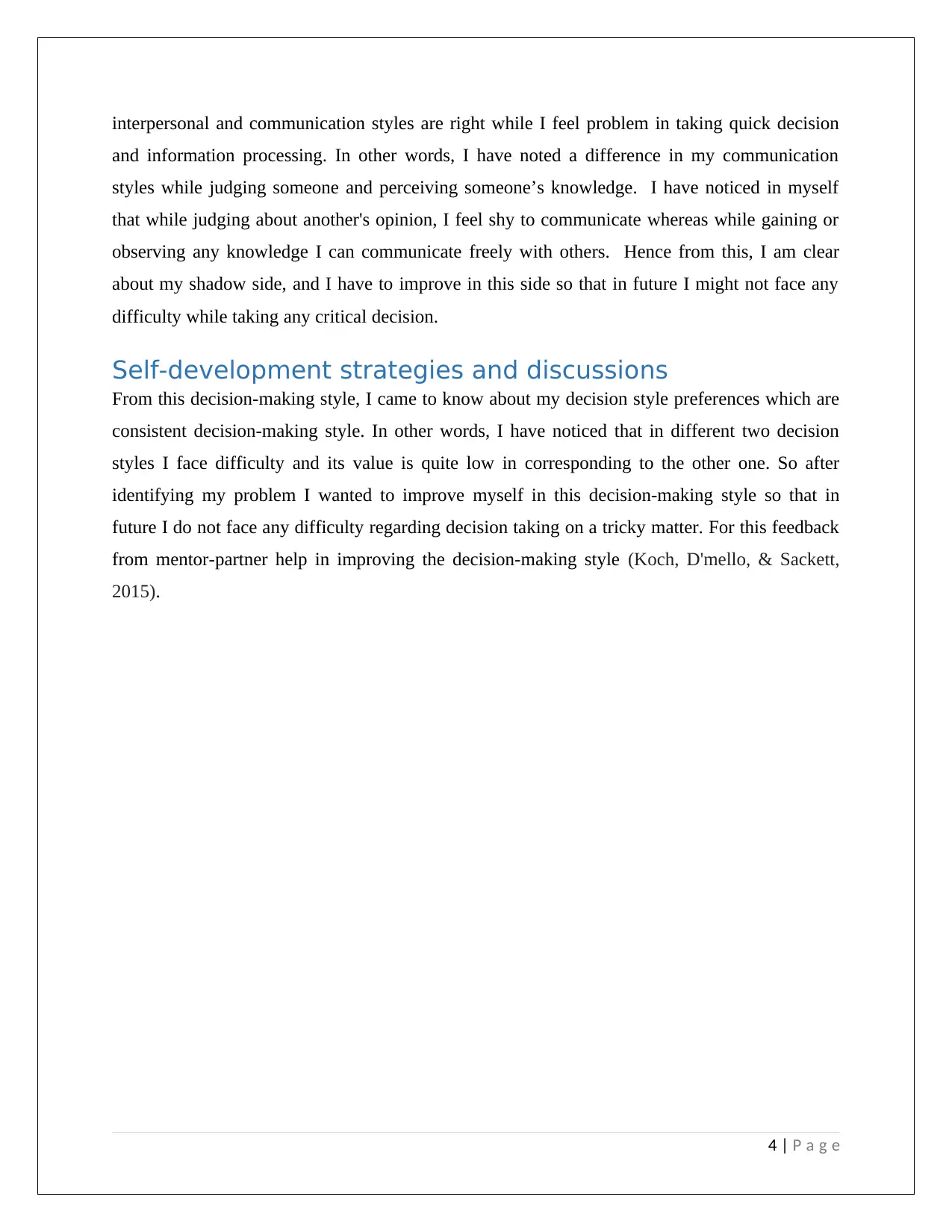
interpersonal and communication styles are right while I feel problem in taking quick decision
and information processing. In other words, I have noted a difference in my communication
styles while judging someone and perceiving someone’s knowledge. I have noticed in myself
that while judging about another's opinion, I feel shy to communicate whereas while gaining or
observing any knowledge I can communicate freely with others. Hence from this, I am clear
about my shadow side, and I have to improve in this side so that in future I might not face any
difficulty while taking any critical decision.
Self-development strategies and discussions
From this decision-making style, I came to know about my decision style preferences which are
consistent decision-making style. In other words, I have noticed that in different two decision
styles I face difficulty and its value is quite low in corresponding to the other one. So after
identifying my problem I wanted to improve myself in this decision-making style so that in
future I do not face any difficulty regarding decision taking on a tricky matter. For this feedback
from mentor-partner help in improving the decision-making style (Koch, D'mello, & Sackett,
2015).
4 | P a g e
and information processing. In other words, I have noted a difference in my communication
styles while judging someone and perceiving someone’s knowledge. I have noticed in myself
that while judging about another's opinion, I feel shy to communicate whereas while gaining or
observing any knowledge I can communicate freely with others. Hence from this, I am clear
about my shadow side, and I have to improve in this side so that in future I might not face any
difficulty while taking any critical decision.
Self-development strategies and discussions
From this decision-making style, I came to know about my decision style preferences which are
consistent decision-making style. In other words, I have noticed that in different two decision
styles I face difficulty and its value is quite low in corresponding to the other one. So after
identifying my problem I wanted to improve myself in this decision-making style so that in
future I do not face any difficulty regarding decision taking on a tricky matter. For this feedback
from mentor-partner help in improving the decision-making style (Koch, D'mello, & Sackett,
2015).
4 | P a g e
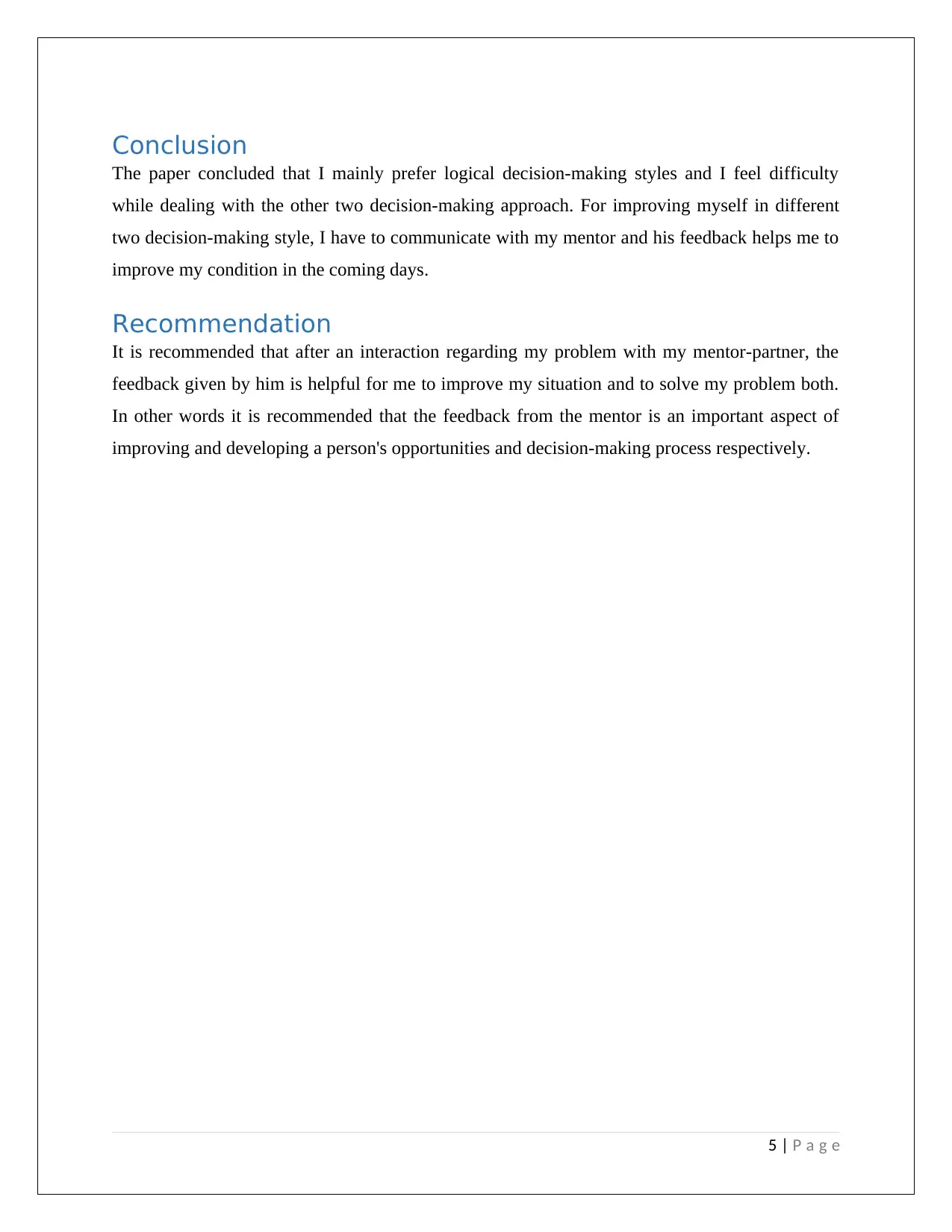
Conclusion
The paper concluded that I mainly prefer logical decision-making styles and I feel difficulty
while dealing with the other two decision-making approach. For improving myself in different
two decision-making style, I have to communicate with my mentor and his feedback helps me to
improve my condition in the coming days.
Recommendation
It is recommended that after an interaction regarding my problem with my mentor-partner, the
feedback given by him is helpful for me to improve my situation and to solve my problem both.
In other words it is recommended that the feedback from the mentor is an important aspect of
improving and developing a person's opportunities and decision-making process respectively.
5 | P a g e
The paper concluded that I mainly prefer logical decision-making styles and I feel difficulty
while dealing with the other two decision-making approach. For improving myself in different
two decision-making style, I have to communicate with my mentor and his feedback helps me to
improve my condition in the coming days.
Recommendation
It is recommended that after an interaction regarding my problem with my mentor-partner, the
feedback given by him is helpful for me to improve my situation and to solve my problem both.
In other words it is recommended that the feedback from the mentor is an important aspect of
improving and developing a person's opportunities and decision-making process respectively.
5 | P a g e
⊘ This is a preview!⊘
Do you want full access?
Subscribe today to unlock all pages.

Trusted by 1+ million students worldwide
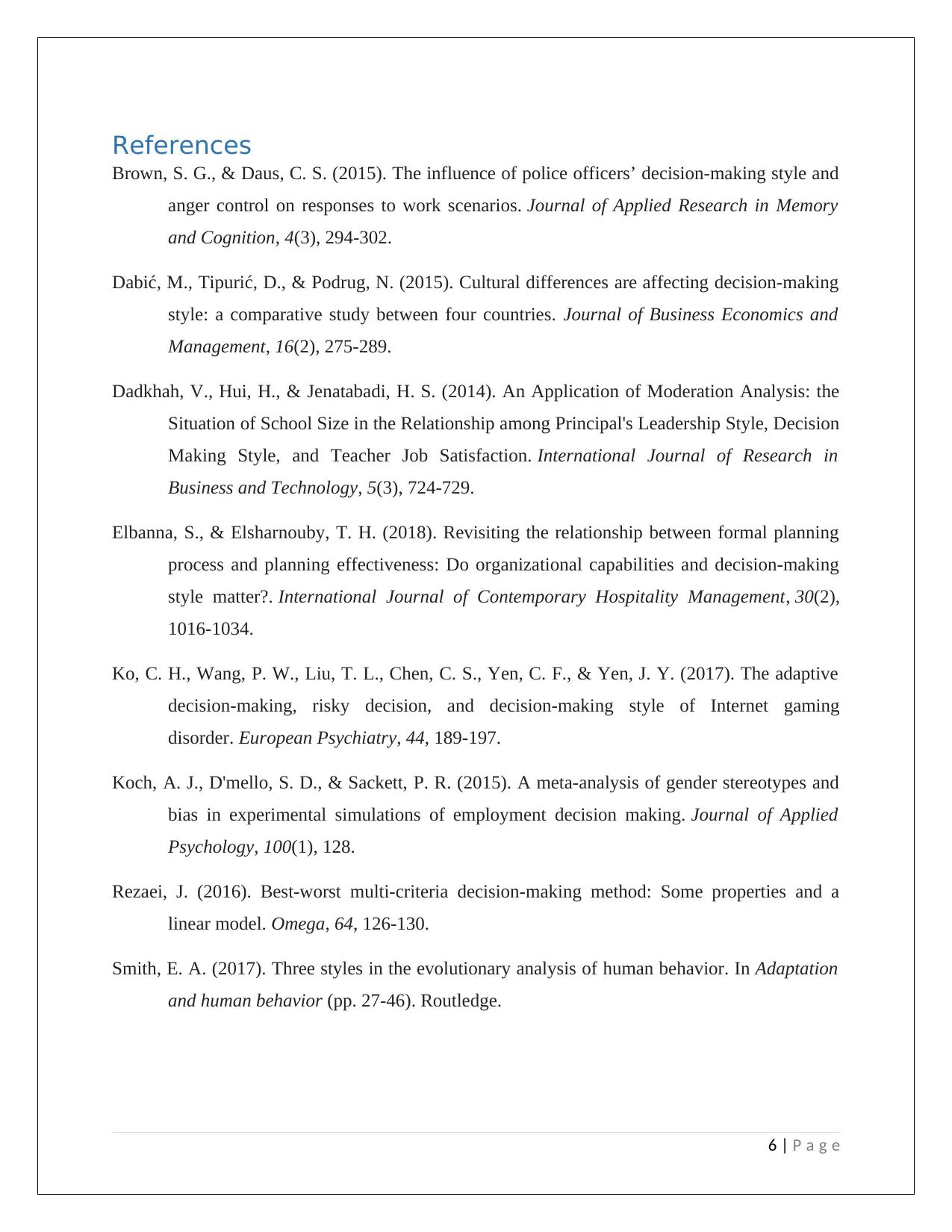
References
Brown, S. G., & Daus, C. S. (2015). The influence of police officers’ decision-making style and
anger control on responses to work scenarios. Journal of Applied Research in Memory
and Cognition, 4(3), 294-302.
Dabić, M., Tipurić, D., & Podrug, N. (2015). Cultural differences are affecting decision-making
style: a comparative study between four countries. Journal of Business Economics and
Management, 16(2), 275-289.
Dadkhah, V., Hui, H., & Jenatabadi, H. S. (2014). An Application of Moderation Analysis: the
Situation of School Size in the Relationship among Principal's Leadership Style, Decision
Making Style, and Teacher Job Satisfaction. International Journal of Research in
Business and Technology, 5(3), 724-729.
Elbanna, S., & Elsharnouby, T. H. (2018). Revisiting the relationship between formal planning
process and planning effectiveness: Do organizational capabilities and decision-making
style matter?. International Journal of Contemporary Hospitality Management, 30(2),
1016-1034.
Ko, C. H., Wang, P. W., Liu, T. L., Chen, C. S., Yen, C. F., & Yen, J. Y. (2017). The adaptive
decision-making, risky decision, and decision-making style of Internet gaming
disorder. European Psychiatry, 44, 189-197.
Koch, A. J., D'mello, S. D., & Sackett, P. R. (2015). A meta-analysis of gender stereotypes and
bias in experimental simulations of employment decision making. Journal of Applied
Psychology, 100(1), 128.
Rezaei, J. (2016). Best-worst multi-criteria decision-making method: Some properties and a
linear model. Omega, 64, 126-130.
Smith, E. A. (2017). Three styles in the evolutionary analysis of human behavior. In Adaptation
and human behavior (pp. 27-46). Routledge.
6 | P a g e
Brown, S. G., & Daus, C. S. (2015). The influence of police officers’ decision-making style and
anger control on responses to work scenarios. Journal of Applied Research in Memory
and Cognition, 4(3), 294-302.
Dabić, M., Tipurić, D., & Podrug, N. (2015). Cultural differences are affecting decision-making
style: a comparative study between four countries. Journal of Business Economics and
Management, 16(2), 275-289.
Dadkhah, V., Hui, H., & Jenatabadi, H. S. (2014). An Application of Moderation Analysis: the
Situation of School Size in the Relationship among Principal's Leadership Style, Decision
Making Style, and Teacher Job Satisfaction. International Journal of Research in
Business and Technology, 5(3), 724-729.
Elbanna, S., & Elsharnouby, T. H. (2018). Revisiting the relationship between formal planning
process and planning effectiveness: Do organizational capabilities and decision-making
style matter?. International Journal of Contemporary Hospitality Management, 30(2),
1016-1034.
Ko, C. H., Wang, P. W., Liu, T. L., Chen, C. S., Yen, C. F., & Yen, J. Y. (2017). The adaptive
decision-making, risky decision, and decision-making style of Internet gaming
disorder. European Psychiatry, 44, 189-197.
Koch, A. J., D'mello, S. D., & Sackett, P. R. (2015). A meta-analysis of gender stereotypes and
bias in experimental simulations of employment decision making. Journal of Applied
Psychology, 100(1), 128.
Rezaei, J. (2016). Best-worst multi-criteria decision-making method: Some properties and a
linear model. Omega, 64, 126-130.
Smith, E. A. (2017). Three styles in the evolutionary analysis of human behavior. In Adaptation
and human behavior (pp. 27-46). Routledge.
6 | P a g e
Paraphrase This Document
Need a fresh take? Get an instant paraphrase of this document with our AI Paraphraser
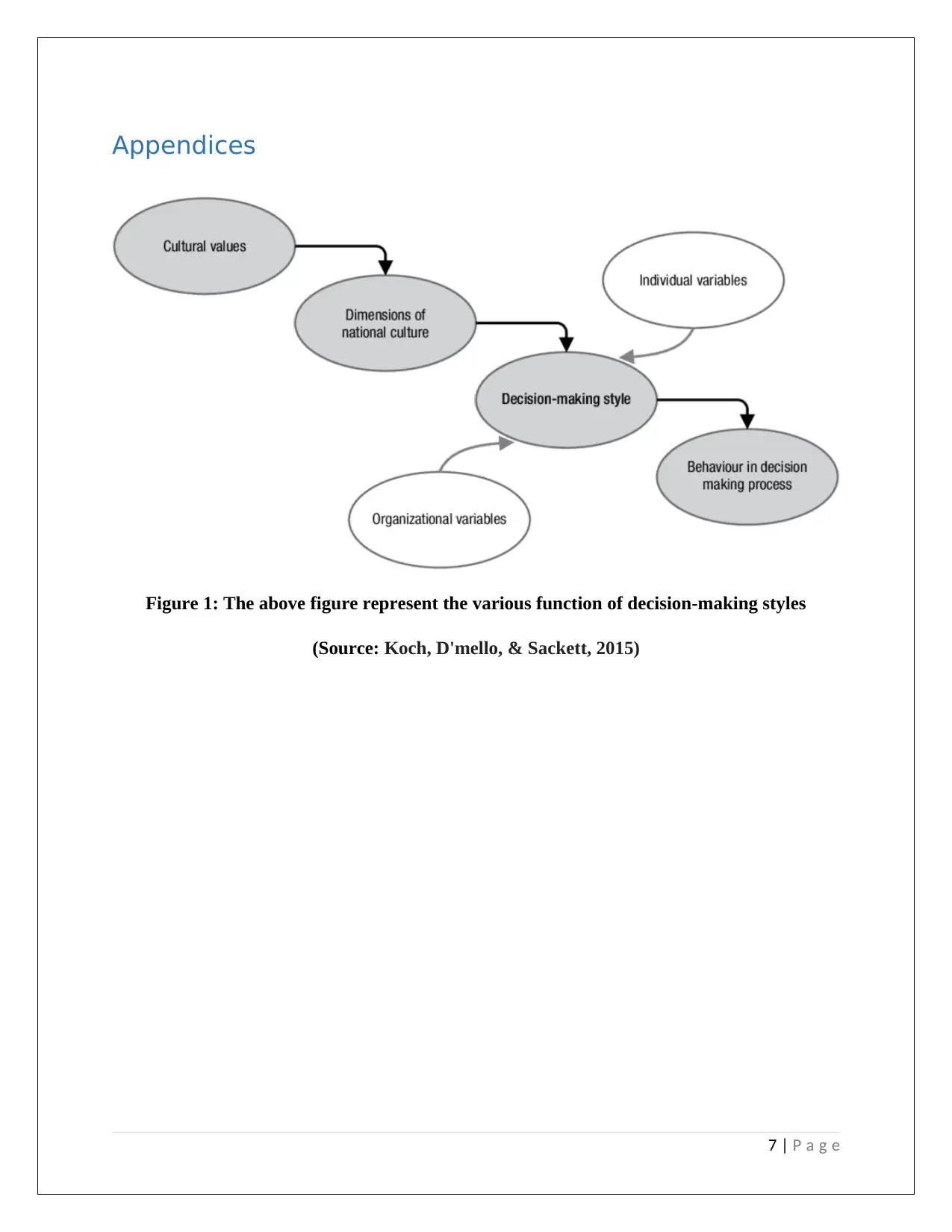
Appendices
Figure 1: The above figure represent the various function of decision-making styles
(Source: Koch, D'mello, & Sackett, 2015)
7 | P a g e
Figure 1: The above figure represent the various function of decision-making styles
(Source: Koch, D'mello, & Sackett, 2015)
7 | P a g e
1 out of 8
Related Documents
Your All-in-One AI-Powered Toolkit for Academic Success.
+13062052269
info@desklib.com
Available 24*7 on WhatsApp / Email
![[object Object]](/_next/static/media/star-bottom.7253800d.svg)
Unlock your academic potential
Copyright © 2020–2025 A2Z Services. All Rights Reserved. Developed and managed by ZUCOL.




